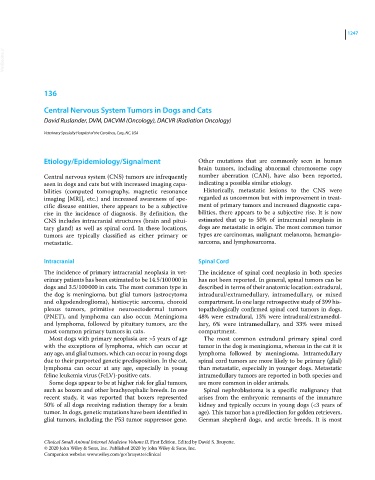Page 1309 - Clinical Small Animal Internal Medicine
P. 1309
1247
VetBooks.ir
136
Central Nervous System Tumors in Dogs and Cats
David Ruslander, DVM, DACVIM (Oncology), DACVR (Radiation Oncology)
Veterinary Specialty Hospital of the Carolinas, Cary, NC, USA
Etiology/Epidemiology/Signalment Other mutations that are commonly seen in human
brain tumors, including abnormal chromosome copy
Central nervous system (CNS) tumors are infrequently number aberration (CAN), have also been reported,
seen in dogs and cats but with increased imaging capa- indicating a possible similar etiology.
bilities (computed tomography, magnetic resonance Historically, metastatic lesions to the CNS were
imaging [MRI], etc.) and increased awareness of spe- regarded as uncommon but with improvement in treat-
cific disease entities, there appears to be a subjective ment of primary tumors and increased diagnostic capa-
rise in the incidence of diagnosis. By definition, the bilities, there appears to be a subjective rise. It is now
CNS includes intracranial structures (brain and pitui- estimated that up to 50% of intracranial neoplasia in
tary gland) as well as spinal cord. In these locations, dogs are metastatic in origin. The most common tumor
tumors are typically classified as either primary or types are carcinomas, malignant melanoma, hemangio-
metastatic. sarcoma, and lymphosarcoma.
Intracranial Spinal Cord
The incidence of primary intracranial neoplasia in vet- The incidence of spinal cord neoplasia in both species
erinary patients has been estimated to be 14.5/100 000 in has not been reported. In general, spinal tumors can be
dogs and 3.5/100 000 in cats. The most common type in described in terms of their anatomic location: extradural,
the dog is meningioma, but glial tumors (astrocytoma intradural/extramedullary, intramedullary, or mixed
and oligodendroglioma), histiocytic sarcoma, choroid compartment. In one large retrospective study of 399 his-
plexus tumors, primitive neuroectodermal tumors topathologically confirmed spinal cord tumors in dogs,
(PNET), and lymphoma can also occur. Meningioma 48% were extradural, 13% were intradural/extramedul-
and lymphoma, followed by pituitary tumors, are the lary, 6% were intramedullary, and 33% were mixed
most common primary tumors in cats. compartment.
Most dogs with primary neoplasia are >5 years of age The most common extradural primary spinal cord
with the exceptions of lymphoma, which can occur at tumor in the dog is meningioma, whereas in the cat it is
any age, and glial tumors, which can occur in young dogs lymphoma followed by meningioma. Intramedullary
due to their purported genetic predisposition. In the cat, spinal cord tumors are more likely to be primary (glial)
lymphoma can occur at any age, especially in young than metastatic, especially in younger dogs. Metastatic
feline leukemia virus (FeLV)‐positive cats. intramedullary tumors are reported in both species and
Some dogs appear to be at higher risk for glial tumors, are more common in older animals.
such as boxers and other brachycephalic breeds. In one Spinal nephroblastoma is a specific malignancy that
recent study, it was reported that boxers represented arises from the embryonic remnants of the immature
50% of all dogs receiving radiation therapy for a brain kidney and typically occurs in young dogs (<3 years of
tumor. In dogs, genetic mutations have been identified in age). This tumor has a predilection for golden retrievers,
glial tumors, including the P53 tumor suppressor gene. German shepherd dogs, and arctic breeds. It is most
Clinical Small Animal Internal Medicine Volume II, First Edition. Edited by David S. Bruyette.
© 2020 John Wiley & Sons, Inc. Published 2020 by John Wiley & Sons, Inc.
Companion website: www.wiley.com/go/bruyette/clinical

